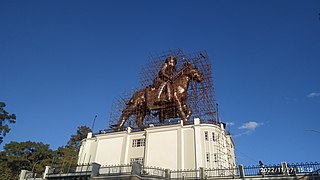
Manipur is a state in northeast India, with the city of Imphal as its capital. It is bounded by the Indian states of Nagaland to the north, Mizoram to the south and Assam to the west. It also borders two regions of Myanmar, Sagaing Region to the east and Chin State to the south. The state covers an area of 22,327 km2 (8,621 sq mi). The official and most widely spoken language is the Meitei language. Native to the Meitei people, it is also used as a lingua franca by smaller communities, who speak a variety of other Tibeto-Burman languages. Manipur has been at the crossroads of Asian economic and cultural exchange for more than 2,500 years. This exchange connects the Indian subcontinent and Central Asia to Southeast Asia, East Asia, Siberia, regions in the Arctic, Micronesia and Polynesia enabling migration of people, cultures and religions.

Sanamahism, also known as Meiteism, or Lainingthouism is an ethnic religion of the Meitei people of Manipur, in Northeast India. It is a polytheistic religion and is named after Lainingthou Sanamahi, one of the most important deities of the Meitei faith. Sanamahi is the eldest son of the supreme god Sidaba Mapu and the supreme goddess Leimarel Sidabi. Traditionally every Meitei household, irrespective of the religion, worships Sanamahi and Leimarel Sidabi. Sanamahism does not have a religious head but has a body, the Maru Loishang, that oversees the main religious activities and governs all affairs of the religion, including the conduct of priest and priestess. The Maru Loishang also acts a court for religious disputes. There are three main departments under the Manu Loishang, namely, the Amaiba Loishang, the Pena Asheiba Loishang, and the Amaibi Loishang. These departments have existed since the reign of King Meidingu Hongnemyoi Khunjao Naothingkhong of Manipur in 662 AD. Sanamahi is the eldest son of the supreme god Sidaba Mapu and the supreme goddess Leimarel Sidabi.

Lai Haraoba is a traditional Meitei religious festival of ritual dance and musical theatre, celebrated annually in honour of Umang Lais, the forest deities of Sanamahism.

Pakhangba is a primordial deity, often represented in the form of a dragon, in Meitei mythology and Sanamahism, the indigenous religion of Manipur. He is depicted in the heraldry of Manipur kingdom, which originated in paphal, mythical illustrations of the deity. It is believed that the ancestor of one of the Meitei clans manifested himself as the Pakhangba.

Manipur is home to a population playing many different sports.

Panthoibi, also known as Nongpok Leima, is a goddess associated with civilization, courage, fertility, handicraft, love, victory, warfare and wisdom in the mythology and religion of Ancient Kangleipak. She is a consort of the God Nongpok Ningthou. She is considered to be one of the divine incarnations of Leimarel Sidabi and is also identified as a form of Goddess Nongthang Leima. She is worshipped mainly by the Meitei people in Manipur, Assam, Tripura, Bangladesh and Myanmar.

Nongshaba is a lion god in Sanamahism and Meitei mythology. He is also regarded as a king of the gods. He is credited with producing light in the primordial universe and is regarded as the maker of the sun. He is worshipped by the people of both the Ningthouja clans as well as the Moirang clans. Nongshaba was worshipped by the people of Moirang clan as a lineage deity and regarded as the father of the god Thangching. He is the greatest of the Umang Lais but he made his only son Thangching the chief deity of Moirang.

Nongpok Ningthou, also known as the Sovereign of the East or King of the East, is a deity in Sanamahism, the indigenous religion of Manipur. He is the ruling guardian deity of the eastern direction. Legend says Nongpok Ningthou and his consort Panthoibi were united in the Nongmaiching Ching mountains. Later, they were worshipped as the civilization giving deities in Meitei religion.

Khoriphaba is a God in Sanamahism, the indigenous religion of Manipur. He is the son of Sky God Salailen and the Goddess Konthoujam Tampha Lairembi. He came down from heaven to earth to search for his mother and then for a bride. He is best known for wrestling with Loyalakpa in the Lai Haraoba festival. He is also a Sagol Kangjei(polo)-playing God.

Khamlangba is a deity in Sanamahism, the indigenous religion of Manipur. He is the God of iron, mining, metallurgy, steel manufacturing, hunting and war. His occupation is the extraction of the iron ores and the manufacture of steel. The Khamlangba Thenlon text mentions about his skills of iron metallurgy and blacksmith in ancient Kakching kingdom.

Loyalakpa is a God in Sanamahism, the indigenous religion of Manipur. He is best known for wrestling with Khoriphaba during the Lai Haraoba festival. He is the consort of goddess Thoudu Nungthel Leima. He is one of the ten kingly gods in Meitei religion.

Koupalu is a primordial deity in Sanamahism. He is the protector of the Meiteis, guardian of the North West direction and the founder of Meitei civilization. He lives on the summit of Mount Koubru.

Pureiromba is a God in Meitei mythology and religion. He is the giver of rain and agricultural prosperity. He is one of the major Umang Lai deities. He is the Ancestor God of the Angom clan of the Meitei ethnicity.

Panam Ningthou is a God in Sanamahism, the indigenous religion of Manipur. He is the protector of crops, especially rice, from hailstorms and thunder. According to legends, He ignited the first fire with flint. He is one of the Umang Lai deities.

Marjing is the God of horses, polo, hockey, sports and war in Sanamahism, the indigenous religion of Manipur. The guardianship of the north eastern direction is alluded to Marjing and the other directions to Koupalu, Thangching and Wangpulen. According to the legend, he invented the game of polo and introduced it as the national game. He and his divine creature, Samadon Ayangba, reside in the top of the Heingang Ching.

Thangching or Thangjing is a primordial deity in Sanamahism, the indigenous religion of Manipur. He is the ruling deity of the Moirang dynasty. He rules supreme on the banks of the landlocked sea, Loktak lake. He is one of the four cardinal Umang Lais. The guardianship of the south western direction is alluded to Thangjing and the other directions to Koubru, Marjing and Wangbren.

Ichum Lairembi is a goddess in Sanamahism, the indigenous religion of Manipur. Her major cult centre of worship is located in Khurkhul.
The Ougri Hangen or the Ougri Hangken is a Meitei cultural ritual song with various appellations of the sun and the mythology of creation. It is often sung in the conclusion of the Lai Haraoba festival. Its theme is closely associated with the creation myth of the earth itself. It is also regarded as the song of thanksgiving to the Almighty God. It is always sung in the chorus formed by the male singers with the maiba as the precentor and is strongly enjoined that the chains of the singers forming a circle should never be snapped. It is also known for its incantatory power, for with the alteration of a few lines, it is believed to have been able to cause either prosperity or destruction of the kingdom and the people.

Jagoi refers to the arts of dance in Meitei culture.

The cultural heritages of Meitei civilization has classicism in diverse traditions of cinemas, dances, language, literature, music, theatre, etc.











